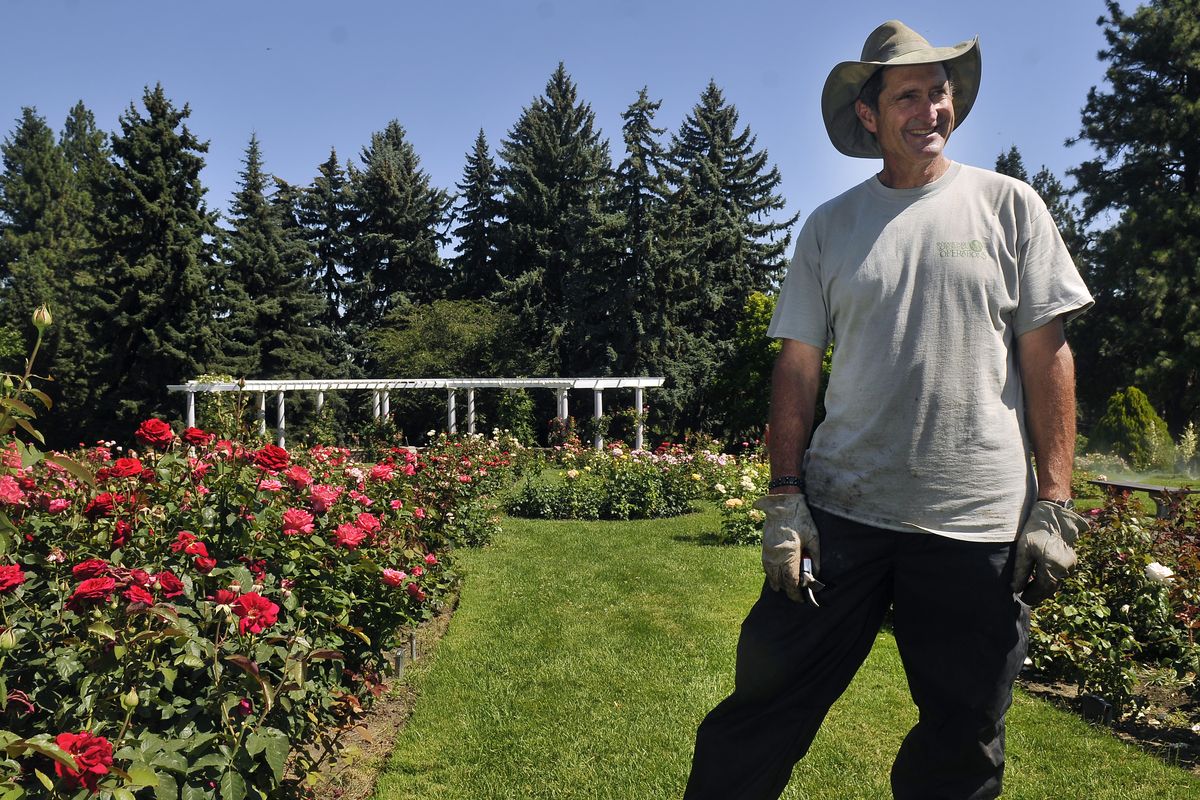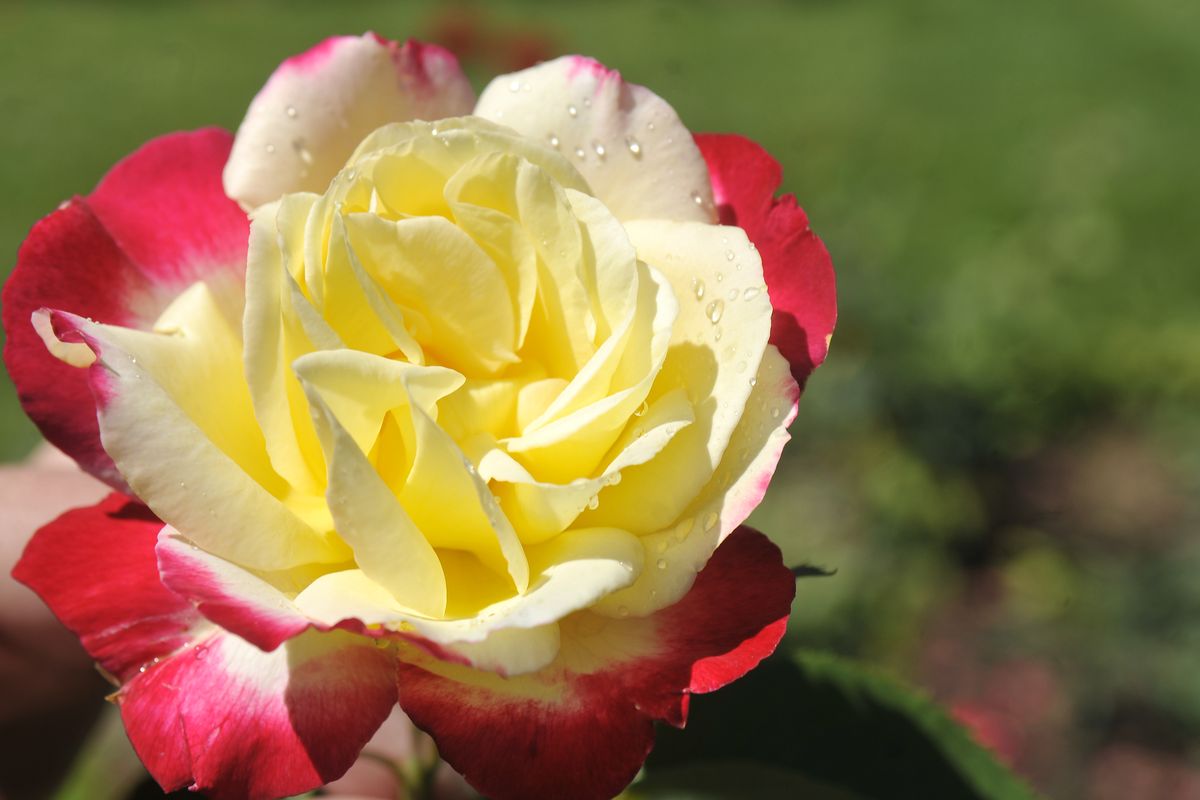Everything’s coming up roses for Manito gardener
Steve Smith stands in the rose garden at Manito Park Friday. Rain or shine, Smith cares for the roses in the rose garden year-round. (Jesse Tinsley)Buy a print of this photo
Imagine beginning your workday surrounded by roses and rainbows. That’s how most summer Fridays begin for Steve Smith, the Manito Park gardener who takes care of the park’s Rose Hill.
Friday is a watering and deadheading day, a time to make sure everything looks good in anticipation of all the weekend visitors who will stroll between the rose beds.
Smith’s day begins at 7:30 a.m. when he hooks up and turns on the first of the sprinklers.
“There are 44 valves up here and we water twice a week,” Smith said, hauling hose and a free-standing sprinkler to a corner of the park. “It’s not necessary to water every day. Not even in this heat.”
On Rose Hill, the sun hits the roses from early morning to late evening and their perfume hangs in the air.
“Can you smell them?” Smith asked. “I’ve gotten so used to them I can’t always smell them.” He has worked in Manito Park for 24 years.
About 2,000 roses grow on Rose Hill, showcasing more than 250 cultivars – even at 7:30 a.m. there are lots of people walking around, taking pictures and smelling the roses. Smith carefully starts one section of sprinklers at a time, making sure no one gets soaked.
“We water the roses between 10 and 20 minutes when we water,” Smith said. “Some people say they don’t like to get wet leaves but we don’t seem to have a problem with that.”
There are about as many opinions about growing roses as there are about parenting.
When asked for advice, Smith is careful to say that this is just the way he does it – this is what works in Manito Park.
Smith said some parameters are the same for all roses:
“They love three things: sunshine, water and fertilizer,” he said.
At Manito, the roses get fertilized in the spring and again in midsummer. Appropriate deadheading assures two, sometimes three rounds of blooming.
“It’s called a ‘flush’ when they bloom, and if it isn’t too cold we will get the last one in September,” Smith said.
Pruning is another topic of debate among rose growers.
Deadheading, the removal of spent blooms, encourages the roses to bloom again.
On Rose Hill, the modern – or hybrid tea – roses are cut back a bit in the fall, covered with mulch for the winter and then cut all the way back in spring.
“We always get scolded in spring,” Smith said, chuckling. “People are worried we cut back too much. I usually just ask them to come back in July and see how well the roses are doing.”
A good modern rose bush is pruned to be open and airy in the middle with canes arching outward and up, perfectly positioned for more blooms. It’s important that canes don’t rub against each other and scrape off bark, opening wounds that may give fungus and insects easy access to the inside of the canes.
“When you prune, you shouldn’t hold back,” Smith said. “It’s almost like you should get into an argument and get a little worked up and then go prune.”
Modern roses are grafted onto a stronger rootstock than what they would produce naturally and sometimes suckers start growing from the rootstock, below the gnarly grafting point.
“Those need to be cut off,” Smith said.
Some roses also produce dead shots, branches that end in a couple of leaves but never produce a bloom.
Smith said to prune those all the way back, or at least back to an outward facing bud.
“Some people leave them because they feel the branch helps the rose because it’s photosynthesizing; we get rid of them,” Smith said.
Modern roses come in thousands of colors and patterns with names like Touch of Class, Betty Boop, Double Delight, Ingrid Bergman and Perfect Moment.
“Many modern roses don’t have much of a scent, but some do,” Smith said.
And what is his favorite?
He doesn’t hesitate to pick Gemini, a classically shaped, peach and white hybrid tea rose.
It’s not just its beautifully shaped blooms and dark shiny foliage that makes it a favorite.
“This rose is very sturdy, it’s very resistant to some of the diseases we see,” Smith said. “The first defense in disease control is to find a resistant cultivar.”
Roses are not as high-maintenance as their reputation.
English roses are grown on their own roots and they may take a little longer to establish, Smith said, but they are often very fragrant with big, full blooms.
Smith said he prefers to spray as little as possible.
Manito staff members ho handle pesticides are recertified every year.
“It’s so important to read the label and understand what it is you are using,” Smith said. “Or look for alternatives.”
Aphids – a common rose pest – can be sprayed with a solution of ordinary dish soap and water.
“Sometimes we just hose them off the plants with cold water and that’s all it takes,” Smith said.
Thrips, tiny insects also known as storm flies or corn lice, eat the leaves and sometimes just the very tip of rosebuds.
“Those can be really hard to get rid of,” Smith said.
And then there are deer visits.
“Deer just love roses – we even get them up here,” Smith said.
As his Friday continues, Smith moves huge sprinklers and hooks up hoses to underground pipes. It takes all day to water Rose Hill.
Drenched from the sprinklers, he pauses to look out over the roses and the flocks of dragonflies swarming about them.
“I have the best job in Spokane,” he said. “There is just no doubt about it.”

